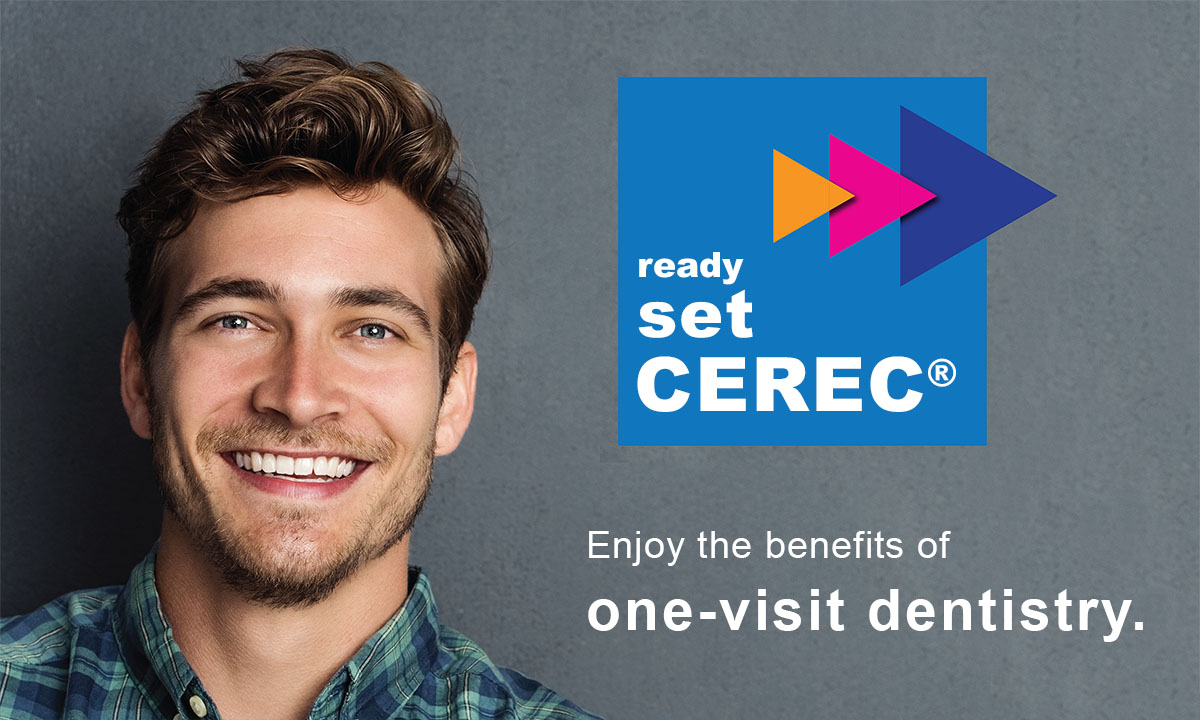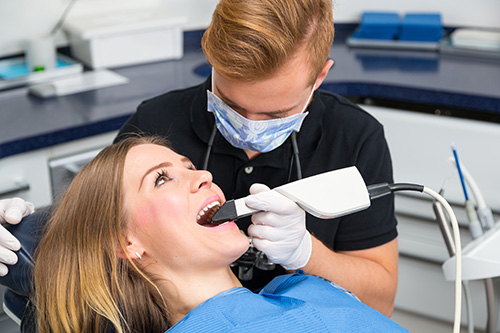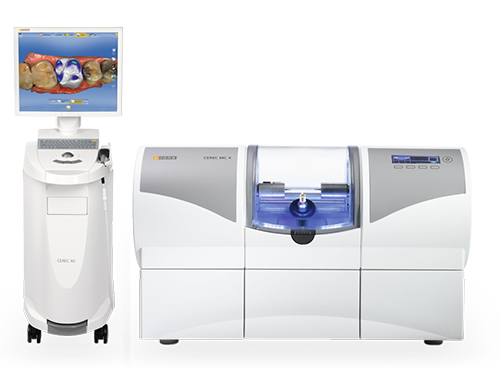
CEREC® brings together digital scanning, computerized design, and on-site milling so patients can leave with a finished restoration in a single visit. That means fewer appointments, less time spent in the chair overall, and the convenience of avoiding temporary restorations while you wait for a lab-made crown.
Beyond convenience, single-visit restorations reduce the number of delicate steps that can introduce error—no removable impressions to distort, no provisional crowns to dislodge. The result is a predictable, well-fitting restoration that restores both function and appearance quickly.
For many patients, that translates into less disruption to daily life: one appointment, one recovery period, and a polished result that blends with the rest of your smile. The efficiency of the process does not compromise the clinical attention each case receives; design and fit are reviewed by your dentist throughout the workflow.

The CEREC approach replaces traditional putty impressions with a comfortable intraoral scan that captures precise three-dimensional data. The scan is processed by specialized software that lets the dentist sculpt a restoration virtually, adjusting contours, contacts, and occlusion before anything is manufactured.
Once the digital design is finalized, the file is sent to a nearby milling unit that carves the restoration from a solid ceramic block. Milling happens right in the treatment room while you wait, and the finished piece is then stained, glazed, or polished to match surrounding teeth.
Because the dentist controls each step—from scanning to final adjustments—there is an opportunity for immediate refinement. This close oversight helps deliver a comfortable fit and a restoration that performs reliably in everyday function.

Contemporary chairside ceramics are designed for strength and esthetics. They resist wear, accept lifelike shades and translucencies, and provide a finish that reflects light similarly to natural enamel. This makes them an excellent option when appearance matters as much as function.
Because many CEREC restorations are fabricated with a conservative approach, they often preserve more healthy tooth structure compared with traditional full-coverage techniques. Preserving natural tooth material supports long-term oral health and contributes to a natural feel when you bite and chew.
When properly bonded, ceramic restorations create a durable interface between restoration and tooth. Your dentist will discuss material choices and the best approach for matching shade and anatomy so the result looks seamless and performs well over time.

CEREC is a versatile option for many restorative needs: single crowns, inlays, onlays, and some veneers. It tends to be particularly appealing for patients who want to minimize appointments or who prefer avoiding temporaries and traditional impressions.
Appropriateness depends on factors such as the extent of tooth damage, bite considerations, and overall oral health. During a clinical evaluation, your dentist will review the condition of the tooth, any previous restorations, and the supporting tissues to determine whether a chairside ceramic restoration is the right choice.
If a restoration requires more complex laboratory techniques or additional steps, your dentist will explain those options and recommend the best course of action. The goal is always to select a solution that balances longevity, function, and appearance for your unique situation.
Your visit typically begins with a focused exam and preparation of the tooth. After removing any decay or old material and shaping the tooth as needed, your dentist will use a fast, noninvasive scanner to acquire digital impressions of the prepared area and surrounding teeth.
Design and milling occur next: the dentist refines the digital restoration, then sends it to the chairside mill. While the ceramic block is machined, your team will complete any necessary shade or texture adjustments. When milling is finished, the restoration is tried in, adjusted for comfort and bite, bonded in place, and polished for a natural finish.
Recovery is generally straightforward. Because the restoration is placed right away, there is no period with a temporary crown, and patients can return to normal activities sooner. Your dentist will provide personalized care instructions to protect the new restoration and maintain overall oral health.
At the office of Dr. Aaron Tropmann & Dr. Gary Oyster, we combine clinical experience with up-to-date digital tools to deliver restorations that meet both aesthetic and functional goals. When CEREC is an appropriate option, it offers a patient-friendly pathway to durable, natural-looking results without the delays of traditional lab work.
If you would like to learn whether chairside ceramic restorations are right for you, please contact us for more information. Our team can explain the process, discuss material choices, and help you understand what to expect at your visit.

CEREC is a chairside CAD/CAM system that enables a dentist to design and fabricate ceramic restorations in a single appointment. The process starts with a fast, noninvasive intraoral scan that captures three-dimensional data of the prepared tooth and adjacent teeth. That digital model is refined with specialized software so contours, contacts and occlusion can be adjusted before manufacturing.
Once the design is finalized, an on-site milling unit carves the restoration from a solid ceramic block while you wait. The milled piece is then stained, glazed or polished and evaluated for fit and esthetics. Finally, the dentist bonds the restoration in place and verifies bite and comfort before concluding the visit.
CEREC is versatile and commonly used for single crowns, inlays, onlays and some veneers. Its digital workflow supports restorations that restore function and appearance while often preserving more healthy tooth structure than traditional full-coverage approaches. Because designs are controlled chairside, the dentist can tailor anatomy and contacts precisely for each case.
Certain complex restorations or situations that require specialized laboratory techniques may still be referred to a dental lab, and your dentist will explain the most appropriate option. Clinical considerations such as the extent of tooth damage, occlusal forces and periodontal health influence the final recommendation. The goal is always a durable, functional and esthetic result suited to the individual patient.
A typical CEREC appointment is completed in a single visit, often during the same day you are prepared for the restoration. Time in the treatment room includes preparation of the tooth, the digital scan, chairside design and milling, followed by finishing and bonding of the restoration. The overall appointment length varies with the complexity of the case and any required preparatory steps.
Your dentist will provide an estimate of the appointment structure during the consultation so you know what to expect on the day of treatment. Because no temporary restoration is required, many patients appreciate the reduction in follow-up visits. Clinical attention to fit and occlusion is maintained throughout to ensure predictable performance.
The CEREC scanning experience is generally comfortable because it replaces traditional putty impressions with a quick, digital camera sweep inside the mouth. Most patients find the scanner less invasive and easier to tolerate than impression trays, especially those with strong gag reflexes. Scans are captured rapidly and the clinician can immediately review the images on-screen to confirm coverage.
If any adjustments are needed to the scan, the clinician can rescan specific areas without repeating an entire impression. That immediacy reduces the chance of remakes due to distorted impressions and contributes to a smoother restorative workflow. Patient comfort and efficient data capture are advantages of the digital approach.
CEREC restorations are milled from contemporary dental ceramics designed for strength, wear resistance and lifelike esthetics. These materials accept shades and translucencies that mimic natural enamel, allowing restorations to blend with surrounding teeth. After milling, restorations can be stained, glazed or polished to achieve a natural surface texture and color match.
When properly bonded to the prepared tooth, ceramic restorations create a durable interface that performs well under normal chewing forces. Your dentist will discuss material choices and select the ceramic best suited to the location and functional demands of the restoration. Attention to shade selection and characterization helps produce a seamless, natural appearance.
Yes—because the CEREC workflow includes digital design and intraoral verification, dentists can sculpt occlusion and proximal contacts precisely during the appointment. The digital model allows careful adjustment of anatomy to ensure the restoration fits harmoniously with neighboring teeth and opposing bites. A try-in and selective adjustment before bonding further refine comfort and function.
Shade matching is achieved through selection of appropriate ceramic blocks and chairside characterization such as staining or glazing. While most cases blend seamlessly, the dentist will review expectations and discuss any esthetic nuances before finalizing the restoration. The hands-on oversight throughout the process supports predictable results.
Good candidates for CEREC restorations are patients who need single-unit restorations such as crowns, inlays or onlays and who value fewer appointments and no temporary restorations. Suitability depends on the condition of the tooth, occlusal considerations, periodontal health and any prior restorations. A comprehensive clinical exam and imaging help the dentist determine whether chairside fabrication is appropriate for an individual case.
Certain situations, such as extensive multi-unit reconstructions or cases requiring specialized lab techniques, may be better served with traditional laboratory-fabricated restorations. Your dentist will explain the clinical reasoning and recommend the option that best balances longevity, function and esthetics for your unique needs. The decision is always based on individualized care planning.
After the milled restoration is evaluated and any necessary adjustments are made, the tooth and restoration are prepared for bonding using standard adhesive protocols. The tooth surface is cleaned and conditioned and the ceramic restoration is treated on its intaglio surface to promote a strong adhesive bond. A resin cement is used to bond the restoration in place and excess material is removed prior to final curing.
Once bonded, the dentist verifies and fine-tunes occlusion and then polishes or finalizes the surface to achieve a natural luster. Proper bonding and finishing are essential to long-term performance and esthetics. Your dentist will provide care instructions and schedule any recommended follow-up to confirm comfort and function.
Caring for a CEREC restoration is similar to caring for natural teeth: maintain daily brushing and flossing and continue regular dental checkups and cleanings. Avoid using teeth as tools and minimize habits that place excessive stress on restorations, such as chewing hard objects. Routine professional exams allow the dentist to monitor contacts, margins and wear patterns over time.
If you experience sensitivity, high spots or discomfort after placement, contact your dental team for evaluation so adjustments can be made promptly. Good oral hygiene and periodic professional maintenance help maximize the restoration's longevity. Your dentist will offer personalized recommendations based on your bite and oral health needs.
During the initial consultation your dentist will perform a focused clinical exam and review any relevant X-rays or imaging to assess the tooth and surrounding structures. The discussion will cover the reasons for restoration, the suitability of chairside CAD/CAM fabrication and any alternative treatment options that may be clinically indicated. The dentist will also explain the treatment steps so you understand the sequence of care on the day of the procedure.
If CEREC is recommended, the team will outline the clinical workflow from tooth preparation through scanning, design, milling and final bonding. You can expect clear communication about anesthesia and any pre- or post-procedure instructions to optimize comfort and outcomes. The consultation is an opportunity to ask questions and ensure the chosen plan fits your preferences and clinical needs.
Our practice integrates experience in restorative dentistry with up-to-date digital tools to deliver single-visit ceramic restorations when clinically appropriate. The team emphasizes precision at each step—scanning, digital design, milling and bonding—to help ensure well-fitting, esthetic outcomes that meet both functional and cosmetic goals. We prioritize clear communication so patients understand the process and expected results.
When you are evaluating restorative options, the office of Dr. Aaron Tropmann & Dr. Gary Oyster will review your clinical condition and recommend the approach best suited to your needs. Personalized treatment planning, attention to detail and follow-up care are central to our approach in achieving durable, natural-looking restorations. We welcome questions and provide thorough explanations to help you make an informed decision.

Ready to book your next appointment or have a question for our team? We're here to help.
Connecting with our team is simple! Our friendly staff is here to help with appointment scheduling, answer any questions about your treatment options, and address any concerns you may have. Whether you prefer to give us a call, send an email, or fill out our convenient online contact form, we’re ready to assist you. Take the first step toward a healthier, brighter smile – reach out to us today and experience the difference compassionate, personalized dental care can make.